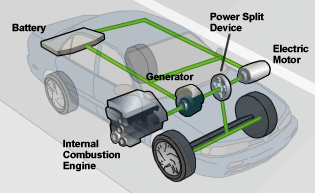Learn everything you want to know about fuel-efficient hybrid cars with All About Hybrid Cars: Maximum Performance Minimum Impact, the eBook with all the answers. Learn what hybrid cars are, how they work and how hybrid cars can save you money while decreasing our nations dependency on foreign oil. View sample chapters.
Hybrid-electric vehicles (HEVs) combine the benefits of gasoline engines and electric motors and can be configured to obtain different objectives, such as improved fuel economy, increased power, or additional auxiliary power for electronic devices and power tools.

Flash Animation: How Hybrids Work
Requires Flash 6.0 or higher.
HTML Version: How Hybrids Work
Some of the advanced technologies typically used by hybrids include
Regenerative Braking. The electric motor applies resistance to the drivetrain causing the wheels to slow down. In return, the energy from the wheels turns the motor, which functions as a generator, converting energy normally wasted during coasting and braking into electricity, which is stored in a battery until needed by the electric motor.
Electric Motor Drive/Assist. The electric motor provides additional power to assist the engine in accelerating, passing, or hill climbing. This allows a smaller, more efficient engine to be used. In some vehicles, the motor alone provides power for low-speed driving conditions where internal combustion engines are least efficient.
Automatic Start/Shutoff. Automatically shuts off the engine when the vehicle comes to a stop and restarts it when the accelerator is pressed. This prevents wasted energy from idling.
For fuel economy information on these vehicles, please visit the Compare Side-by-Side section.